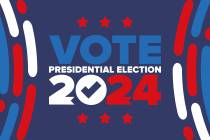Nevada’s shift to federal Obamacare won’t be smooth

Laury Phelps is beyond desperate.
The 63-year-old Las Vegan signed up in October through Nevada Health Link for insurance that would begin Jan. 1. She canceled her existing coverage and paid her first premium in December for a federally subsidized plan through the state exchange, which was created by the Affordable Care Act to help consumers buy insurance.
Eight months later, Phelps has no coverage. She said she feels like she’s stuck in the Byzantine bureaucracy of a Franz Kafka novel: No one can tell her why her application can’t get through the system, except for vague pronouncements about needing more details from her.
“I really do just want to scream. What other information do they need? They know more about me than my own family does,” she said. “It’s so frustrating. If I wake up sick, I can’t go to the doctor. They really do seem to have your fate in their hands, and they don’t seem to care.”
Now Phelps — along with Nevada’s 38,000 other state exchange enrollees — is hearing that she will have to redo her enrollment application from scratch in the fall, when the exchange drops its flubbed Nevada Health Link website software and adopts the federal Healthcare.gov enrollment system for a year.
The idea of signing up all over again could send consumers streaming for the exit doors, Phelps said.
“I definitely know there are people who will say, ‘Forget about it,’ ” she said. “A lot of people are just going to give up on it. A lot of people are totally frustrated.”
Healthcare.gov is supposed to fix Nevada’s Obamacare sign-up woes. But with consumer faith in exchanges badly shaken, not to mention lingering technical concerns with the incomplete federal site, observers say the Silver State is all but sure to face headwinds when enrollment begins again on Nov. 15. If those headwinds are strong enough, the exchange — which struggled from October through May to reach a third of the expected 118,000 sign-ups in its first year — could again miss targets, industry observers say.
“The biggest concern is that we’re going to have to rewrite everyone on the federal exchange, and there’s no guarantee it’s going to work,” said Chris Carothers, president of Carothers Insurance Agency in Las Vegas.
BUMPY RIDE
While re-enrollment is a concern for insurers, brokers and consumers, shifting to Healthcare.gov has definite benefits: Insurers and IT experts agree the federal infrastructure offers a far more efficient plan-shopping process. Better yet, it will end billing and payment problems that bedevil Xerox’s Nevada Health Link site.
“That will alleviate quite a bit of the problems some Nevadans were having making payments,” said Nevada Health Link spokesman CJ Bawden. “Coverage will effectuate because people will be able to get online, get an eligibility determination, select a plan and have the carrier send them an invoice,” rather than waiting for the exchange to send insurers sign-up details and mail premium bills.
Pat Casale, a Las Vegas insurance broker who’s been working to get Laury Phelps coverage, said letting insurers bill directly to consumers will eliminate 75 percent of exchange problems.
Yet Healthcare.gov, overseen by the federal Centers for Medicare and Medicaid Services, has its own flaws. Insurers say it doesn’t consistently reconcile enrollments with actual customers. It sometimes submits the wrong tax-credit details. The U.S. Government Accountability Office in July blasted the Centers for Medicare and Medicaid Services over the incomplete website’s mismanagement, warning of “significant risks” of future enrollment trouble.
“It begs the question of whether Nevada is trading one problem for another,” said Dan Schuyler, senior director at Leavitt Partners, a Utah-based health industry research firm that studies insurance exchanges. “Some (Healthcare.gov) functions are still under development, and it’s going to be a bumpy ride in November.”
Healthcare.gov’s history sounds like that of Nevada Health Link.
Healthcare.gov contractor CGI hadn’t finished building the site when it debuted Oct. 1. Missing was the back end, including the system to track premium payments and subsidies. The site wouldn’t let people compare plan costs and designs before wrestling with registration. Conflicting software codes caused bottlenecks.
As nearly 9 million people flooded Healthcare.gov in its first week, the site crashed. It wasn’t just high traffic hobbling the system; programming threw up hurdles as well. Users had trouble even getting past security-question setup. The website was down 60 percent of the time in its first few weeks, according to a January report by the Maine-based National Academy for State Health Policy.
Nevada Health Link didn’t crash at that rate, but it shares other experiences with Healthcare.gov.
Xerox, which won a $72 million contract for Nevada’s website build, missed multiple deadlines. Nevada Health Link went live in October without its back end, where Medicaid applications go to the state Division of Welfare and Supportive Services, and where premium invoices are created, enrollment details are sent to insurers and consumers can change plans.
There was one key difference between Healthcare.gov and Nevada Health Link. The Centers for Medicare and Medicaid Services was far faster with big changes, including firing contractor CGI in January and hiring consulting firm Accenture to clean up the mess. The state exchange’s board didn’t cut loose Xerox until May, leaving few options beyond quickly moving to borrow federal functions for November’s enrollment period.
In adopting Healthcare.gov’s enrollment and eligibility functions, the exchange brings in a website that seems to work for most consumers.
By the end of February, the Centers for Medicare and Medicaid Services had slashed the number of screens users had to fight through to sign up, added online help for complex family situations and made it easier for people to report life changes that affect coverage.
The National Academy for State Health Policy lauded the site’s “significant upgrades and improvements in capacity,” which let consumers “more successfully shop for plans” on a site that loaded faster and had fewer errors by early 2014.
Insurers also say they don’t see outages nearly as often as they did in the site’s early days, and it’s now much easier to shop, get quotes, apply and enroll.
“From a front-end consumer perspective, enrollment will be fairly seamless,” Schuyler said.
There’s also a federal education requirement for insurance brokers who want to sign clients through the exchange. That, combined with the fact that the federal system is actually functional, should lure additional brokers with national firms, boosting the amount of help available to consumers, said Brent Leavitt, the Nevada Benefits Corp. agent who signed up more Nevada Health Link customers than any other broker. (Leavitt is also a Republican candidate for State Assembly District 7.)
None of those improvements mean the state exchange is home-free in the next enrollment session.
LINGERING DOUBTS
Healthcare.gov’s back end still isn’t finished, and that “leaves the burden on carriers once again” to sort out enrollment details, Schuyler said. The system that electronically reconciles and pays premium subsidies is still in development nearly a year after its scheduled Oct. 1 start. Schuyler said it might not be ready by Nov. 15.
That’s a problem because insurers report a disconnect between what the feds say a consumer’s subsidy should be and what the enrollee says it should be. That disputed information isn’t making it to carriers. And if the tax credit is wrong, consumers could pay too much for coverage or end up with a bill from the IRS.
Carriers also say the federal site’s monthly membership reconciliations are unreliable, with those functions still being rolled out. That could mean inconsistent information on addresses, cancellations and even plan selections — a problem when it’s time to send out renewal notices.
Brokers are eyeing that potential issue as well.
“Is our information still going to make it to the carriers? None of us is privy to the answer to that,” Carothers said.
Most important, experts say, are questions about whether Healthcare.gov can handle yet another crush of early traffic from first-time enrollees to existing customers renewing plans.
Leavitt, who signed up more than 300 people from October to May, said he expects “a lot more” traffic the second time around. And Healthcare.gov did struggle toward the end of March, going down for maintenance on the last day of open enrollment.
“I’m trying to make it as easy as possible, but I think it’s going to be a nightmare again,” Leavitt said. “We’re getting a lot of (consumers with qualifying life events) enrolling now as health plans start to cancel, and all of the companies that renewed early last year have to renew in the fall. We also have a lot of people who held off the first time to see how it went. They’re now ready to jump in. It could crush the system if they don’t have the server support.”
Nor is it clear whether Healthcare.gov will tell consumers what they need to know to choose the right plan. The site is supposed to use measurements such as prior out-of-pocket spending, income and health status to guide shoppers to the best plans for their households. Those decision-making tools were not “robust” the first time around, Schuyler said, and fixing them probably isn’t high-priority.
But even the best enrollment tools won’t matter if people don’t want to endure another sign up.
MORE EXPENSE
Phelps may be in that camp herself.
The exchange cashed her checks and charged her credit cards for $248 per month for premiums from January through September. Along the way, Phelps was told her Social Security number didn’t exist. She received form letters telling her she has no policy. Call center representatives keep telling her they need more information, without detailing what else they need to know. Neither exchange officials nor her insurance broker can tell her when her coverage might begin. She said she must weigh quitting some of the medications that now cost her $800 per month out of pocket.
“I don’t think anyone who’s had a problem has any real faith in what (the exchanges) are doing,” Phelps said. “Using a new system doesn’t make me feel better, because they told us this current system would work. Calling Nevada Health Link and trying to get through on their phones — it’s worse than going to the DMV or the Social Security office and sitting there with 500 people.”
Bawden promised marketing and advertising that will boost awareness about re-enrolling, letting people know the exchange has streamlined the application process and added more insurers and and new plans.
But comments like Phelps’ are especially disconcerting to insurers, who joined exchanges expecting automatic renewals to develop customer loyalty.
Said Robert Ruiz-Moss, vice president of exchange strategy and execution for WellPoint, the parent company of Anthem Blue Cross and Blue Shield in Nevada: “The less action people have to take to stay covered, the more likely they are to stay covered. Every time you require a greater level of engagement, the risk is that some people will go uncovered. This will have to be addressed through messaging and support.”
That goes for brokers, too.
“How much time is it going to take, knowing that I have to relearn everything? I developed forms to enroll people. I don’t know if I’m going to have to develop new questionnaires. The only reason I had a paper trail is because I built them and shared them with many agents across the industry,” Carothers said.
Brokers also fret about reaching federal officials if something goes wrong.
“I’m scared to death, because we’re not going to have as much control over service issues as we’ve had over the past year,” said Casale, who’s used to calling exchange executives and Gov. Brian Sandoval’s office directly for help with tough cases.
What’s more, consumers could face re-enrollment again in October 2015, if the state exchange chooses a new, private vendor and system to rebuild Nevada Health Link.
That move might also cost Nevada more, Schuyler said.
When Maryland abandoned its system and bought the Deloitte Consulting software that runs Connecticut’s marketplace, the Centers for Medicare and Medicaid Services, which also distributes start-up grant money to state exchanges, refused grant money to pay for the changeover. That’s likely going to be the case in Nevada as well, Schuyler said.
Contact reporter Jennifer Robison at jrobison@reviewjournal.com. Follow @J_Robison1 on Twitter.


















